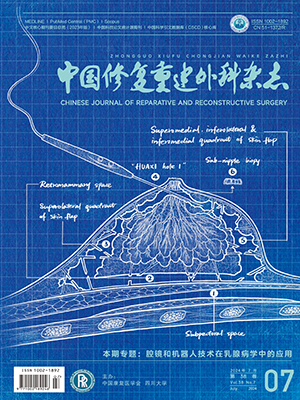Objective To summarize and analyze the clinical experience and theclinical outcome of treating tumorous diseases in the proximal femur by the customized hip arthroplasty. Methods Eleven patients (7 males and4 females, aged 40-69 years) with a tumorous disease in the proximal femur received a removal ofthe proximal femur and the customized hip arthroplasty from February 1994 to November 2002. Of the 11 patients, 7 had giant cell tumor in the proximal femur, 2 had chondroblastoma, 1 had osteitis deformans, and 1 had fibrous dysplasia. Six patients received the artificial total hip replacement and 5 underwent the dipolar-cup artificial femoral head prosthesis replacement. Results The follow-upfor 1-5 years in 9 patients (2 patients lost the follow-up) revealed that afteroperation one patient with hemorrhage from the incision had been given a local compression for 5 days, and finally lost the function of the quadriceps muscle and had sensory deprivation in the anterior part of the thigh. Five years later, the patient had a quadriceps muscle power of the “0” degree, a decreased sensation, the “3” degree of the hamstring and the extension and flexion muscles of the lower limb, with lameness and crutch walking. The quadriceps muscle powertest showed that 5 patients had the “3” degree of the muscle power and 2 of them had paroxysms of pain in the upper part of the thigh, especially after a long time of standing and walking, so both of them received the dipolar-cup artificial femoral head prosthesis replacement. Three patients had the “4” degree of the quadriceps muscle power, with an extension range of the hip joint of 10°27° and an average flexion degree of 74°. According to the Harris scale, 3 patientswere assessed to be good (8089), 5 moderate (70-79), but 1 bad ( lt;70). No infection, recurrence or the loosening of the prosthesis was found in all the patients during the follow-up. Conclusion The customized hip arthroplasty has a goodclinical outcome in treatment of a tumorous disease in the proximal femur. However, there is a high incidence of deficiency of the quadriceps muscle power after operation, which may be relevant to the removal of the upper attachment of the quadriceps muscle. If the attachment of the quadriceps muscle, especially the internal, external and posterior septum attachment, can be fixed in the body of the prosthesis during operation, the power of the quadriceps muscle can be enhanced and the patient can have a better therapeutic effect.
Citation: GUO Wei,LI Rongwen,XU Guanghui,et al.. TREATMENT OF TUMOROUS DISEASE IN PROXIMAL FEMUR BY CUSTOMIZED HIP ARTHROPLASTY. Chinese Journal of Reparative and Reconstructive Surgery, 2006, 20(10): 989-991. doi: Copy




